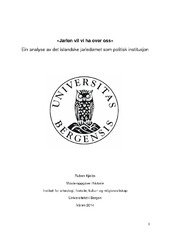| dc.contributor.author | Kjølås, Ruben | eng |
| dc.date.accessioned | 2014-09-01T09:19:13Z | |
| dc.date.available | 2014-09-01T09:19:13Z | |
| dc.date.issued | 2014-05-14 | eng |
| dc.date.submitted | 2014-05-14 | eng |
| dc.identifier.uri | https://hdl.handle.net/1956/8391 | |
| dc.description.abstract | Hovudmålet i denne oppgåva er å analysere det islandske jarledømet som ein politisk institusjon. Jarledømet eksisterte berre i ti år, og jarlen var den islandske goden (høvdingen) Gissur Torvaldsson (1208-68). Han heldt jarledømet som len av den norske kongen Håkon Håkonsson (1204-63). Oppgåva er delt i fire kapittel. Målet i det første kapittelet er å presentere det islandske jarledømets historiografi og å drøfte kjeldematerialet som blir brukt i oppgåva. Dette materialet inkluderer soger, lover, traktatar og annalar. I det andre kapittelet drøftar eg bakgrunnen for etableringa av jarledømet på bakgrunn av Sturlungastriden mellom dei ulike godane (høvdingane) på Island i første halvdel av 1200- talet. Gissur Torvaldsson var ein av desse godane, som etter kvart vann kong Håkons tillit, og vart gjort til jarl over Sørlands- og Nordlandsfjerdingane, i tillegg til Borgarfjörður, som kong Håkon hadde overherredøme over. I dette kapittelet drøftar eg også jarleverdigheita elles i den norrøne verda, der jarledøma i Noreg og på Orknøyane er dei mest interessante samanlikningsobjekta til det islandske jarledømet. I det tredje kapittelet gjer eg greie for maktkjeldene til Gissur jarl. Dei ulike kjeldene blir delt inn i politiske, militære, økonomiske og ideologiske maktkjelder. Gissur prøvde å kombinere si stilling som ein tradisjonell islandsk gode med den stillinga han hadde som den norske kongens jarl og vasall. Han bygde opp ein politisk og militær organisasjon som kombinerte aspekt frå begge institusjonar. Hans økonomiske makt baserte seg hovudsakeleg på inntektene frå hans eigne jordeigedomar. I det fjerde kapittelet drøftar eg Gissur jarls rolle i prosessen då Island vart eit skattland under den norske kongen i åra 1262-64. Gissur var i eit dilemma sidan han hadde sine plikter som gode for sine tingmenn og andre plikter som den norske kongens jarl. Under press frå den kongelege utsendingen Hallvard Gullsko og andre islandske godar, overtydde han endeleg sine tingmenn om å bli den norske kongens skattebetalande undersåttar. No måtte islendingane betale skatt i tillegg til det tradisjonelle tingfarekaupet. Det blir argumentert for at Gissur fekk behalde tingfarekaupet, men måtte dele den nye skatten med kongen. Så vidt vi veit, var Gissur ein lojal kongens vasall inntil han døydde i 1268. Sjølv om der er seinare referansar til ein islandsk jarl i kjeldene, døydde sannsynlegvis jarledømet som politisk institusjon ut ved Gissurs død. | en_US |
| dc.description.abstract | The primary aim of this thesis is to analyse the Icelandic earldom as a political institution. The earldom existed for only ten years, between 1258 and 68, and was held by the Icelandic goði (chieftain) Gizurr Thorvaldsson (1208-68). He held the earldom as a fief from the Norwegian king Håkon Håkonsson (1204-63). The thesis is divided into four chapters. The object of the first chapter is to present the historiography of the Icelandic earldom and to discuss the source material that is used in the thesis. This material includes sagas, laws, treaties and annals. In the second chapter I discuss the background for the establishment of the Icelandic earldom in the context of the Sturlunga strife between the various chieftains (goðar) in Iceland in the first half of the 13th century. Gizurr Thorvaldsson was one of these goðar, who eventually gained king Håkon's trust, and was given the title earl over the Southern and Northern Quarters, as well as Borgarfjörður, over which king Håkon had overlordship. Also in this chapter, the title of earl is discussed within the context of the wider Norse world, where the earldoms of mainland Norway and the Orkneys are the most interesting comparisons to the Icelandic earldom. In the third chapter, the sources for earl Gizurr's power are examined. The different sources are divided into political, military, economical and ideological sources of power. Gizurr tried to combine his position as a traditional Icelandic chieftain with that of an earl and vassal of the Norwegian king. He built up a political and military organisation that combined aspects from both institutions. Furthermore, his economical power rested primarily on the revenue from his own land. In the fourth chapter, earl Gizurr's role is discussed in the process of making Iceland a dependency under the Norwegian king in the years 1262-64. Gizurr was in a dilemma since he had duties as a chieftain to his thingmen and other duties as an earl of the Norwegian king. Under pressure from the royal emissary Hallvard the Golden Shoe and other Icelandic chieftains, he finally persuaded his thingmen to become tax- paying subjects of the Norwegian king. Now, the Icelanders had to pay taxes in addition to the traditional þingfararkaup. It is argued that Gizurr was allowed to keep the þingfararkaup at his disposal, but had to share the new tax with the king. As far as we know, earl Gizurr remained a loyal vassal of the crown until his death in 1268. Despite some later references to an Icelandic earl in the sources, the earldom probably vanished as a political institution at Gizurr's death. | en_US |
| dc.format.extent | 1015876 bytes | eng |
| dc.format.mimetype | application/pdf | eng |
| dc.language.iso | nno | eng |
| dc.publisher | The University of Bergen | eng |
| dc.subject | Island | |
| dc.subject | Middelalderen | |
| dc.subject | Styresett | |
| dc.subject | 1200-tallet | eng |
| dc.title | «Jarlen vil vi ha over oss» - Ein analyse av det islandske jarledømet som politisk institusjon | eng |
| dc.type | Master thesis | |
| dc.rights.holder | Copyright the author. All rights reserved | |
| dc.description.degree | Master i Historie | |
| dc.description.localcode | MAHF-HIS | |
| dc.description.localcode | HIS350 | |
| dc.subject.nus | 713107 | eng |
| fs.subjectcode | HIS350 | |
